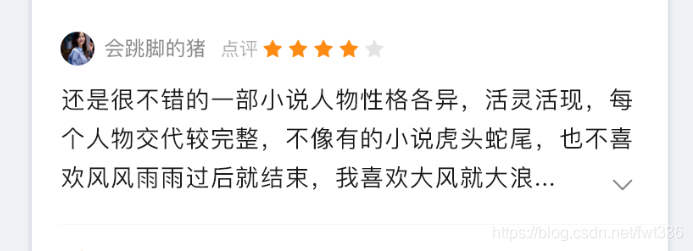先上需求图:

网上见的跟多的是把向下图标换成“更多”字样,然后都可以点击。而我这个是点击展开后不需要显示收缩按钮,其实要做还是可以的。
我主要是通过布局来实现的,属于取巧。
布局代码:用相对布局包裹内容和图标
<RelativeLayout
android:id="@+id/booke_detail_resume_layout"
android:layout_width="match_parent"
android:layout_height="wrap_content"
>
<TextView
android:id="@+id/book_comment_item_comment"
android:layout_width="match_parent"
android:layout_height="wrap_content"
android:textColor="@color/color_1b1b1b"
android:ellipsize="end"
android:gravity=""
android:padding="32,0,32,35"
android:lineSpacingMultiplier="1.2"
app:x_text_size="28"
/>
<XRelativeLayout
android:id="@+id/book_detail_open"
android:layout_width="126px"
android:layout_height="wrap_content"
android:visibility="gone"
android:layout_alignParentRight="true"
android:layout_alignParentBottom="true"
android:padding="70,20,32,40"
>
<ImageView
android:id="@+id/book_more_img"
android:layout_width="wrap_content"
android:layout_height="wrap_content"
android:layout_alignParentRight="true"
android:layout_alignParentBottom="true"
android:src="@mipmap/open"
app:x_layout_size="24,14"
/>
</RelativeLayout>
</RelativeLayout>
布局不用直接拷贝,因为会报错,理解即可。
代码包括两部分:初始化和监听
初始化代码:
if (!TextUtils.isEmpty(commentBean.getContent())) {
tvContent.setText(commentBean.getContent());
moreLayout.setTag(commentBean.getContent());
if (handler != null) {
handler.postDelayed(new Runnable() {
@Override
public void run() {
tvContent.setVisibility(View.VISIBLE);
if (tvContent.getLineCount() > 3) {
tvContent.setMaxLines(3);
moreLayout.setVisibility(View.VISIBLE);
int lineEndIndex = tvContent.getLayout().getLineEnd(2);
String text = tvContent.getText().subSequence(0, lineEndIndex - 4) + "...";
tvContent.setText(text);
} else {
moreLayout.setVisibility(View.GONE);
}
}
}, 100);
}
}
监听:
moreLayout.setOnClickListener(new View.OnClickListener() {
@Override
public void onClick(View v) {
if (tvContent.getLineCount() > 3) {
tvContent.setMaxLines(3);
int lineEndIndex = tvContent.getLayout().getLineEnd(2);
String text = tvContent.getText().subSequence(0, lineEndIndex - 5) + "...";
tvContent.setText(text);
} else {
tvContent.setMaxLines(Integer.MAX_VALUE / 2);
tvContent.setText((String)v.getTag());
}
moreLayout.setVisibility(View.GONE); // 我们的需求不需要收缩,就直径隐藏了
}
});
具体在使用的过程中,需要自己调整图标的上下位置,调整好就可以了。